

16 Best Trimarans For Sailing Around The World (And a Few For Daysailing)
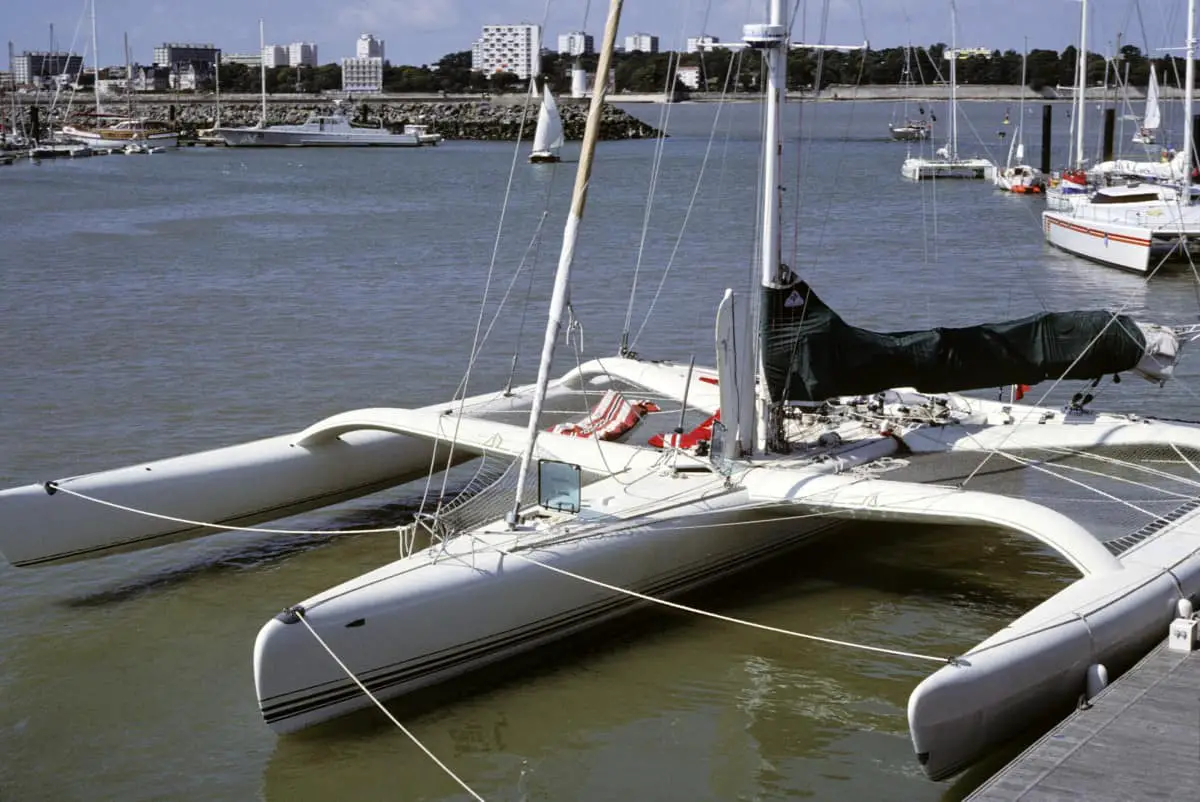
As an Amazon Associate, we earn from qualifying purchases. We may also earn commissions if you purchase products from other retailers after clicking on a link from our site.
Trimarans are growing in popularity worldwide, due to their light construction and high stability these multihulls are even faster than catamarans. Trimarans are still one of the lesser-known boat types so in this article ill be checking out some of the most popular models.
The best trimarans include:
- The Neel 43
- The Neel 47
- Dragonfly 28
- The Pulse 600
- Corsair 37
These tris are built with your safety in mind while also packing powerful speed and a wide array of comfort features to optimize your sailing experience , some are even foldable making them possible to load on a trailer and transport to the sailing destination of your choosing.
In this article, I have created a list of the 16 best trimarans in the market and their unique features. You’ll also learn the best options for different purposes such as circumnavigation, weekend sailing, racing, and more.
Table of Contents
What Is a Trimaran?

A trimaran is a multi hulled sailboat with three individual hulls; the main hull ( vaka ) and a pair of outrigger hulls ( amas ). These smaller outrigger hulls are attached to the main hull using beams.
While trimarans have a rich history dating back nearly four millennia, these types of sailboats have only gained popularity in the late 1900s and early 2000s.
Trimarans are primarily used as personal boats for sailing enthusiasts or racing. These sailboats draw their versatility from their lightweight design, making them faster and easier to handle at sea when compared to single-hulled boats (monohulls). Additionally, the three hulls also contribute to better stability, making it very hard to capsize (although more likely than a cat according to this study)
Trimarans come in various sizes, and some can be as small as 19 feet (5.8 meters) in length, while others go up to 60 feet (18meters). They’re also used for different purposes. Most trimarans are used for racing and recreational purposes, although some units are still used as ferries.
As with all things, to find out which is the best we need to understand what it will be used for. There is a big difference in requirements between a boat used for day sailing compared to offshore around the world sailing.
The list below highlights the best trimarans for different purposes.
Best Trimarans For Cruising, Liveaboard and Sailing Around The World
The Neel 43 is a French trimaran best suited for cruising. Its key features include:
- Easy maneuverability on the open sea by only a small number of crew members
This unit is also built for comfort, ideal for more extended travels. This 43-feet (13-meter) trimaran is also made with recyclable and bio-sourced materials, highlighting the manufacturer’s commitment to environmental consciousness.
This trimaran has a base price of €329,000 excluding VAT. This translates to approximately $370,138.
2.Neel 47 Possibly The Best
Named the best full-size multihull for 2020, the Neel 47 is a strong contender for one of the best trimarans in the market. This 47-foot (14.3-meter) long trimaran features optimized exterior and interior ergonomics for a unique design and look.
Still on design, the Neel 47 is ideal for couples looking to take a weekend off or spend some time as liveaboard. It has a spacious owner’s cabin and two bedrooms. It also features a spacious living room and kitchen and is optimized to ensure comfort for a couple.
The Neel 47 also has two basic guest cabins so your friends or children can tag along on your sailing adventure. Accordingly, this unit is ideal for those looking to explore the sea for the sheer joy of sailing.
The Neel 47 comes at a 571,139 euro ( $643,600 ) price tag, excluding VAT.
3. Rapido 60 The Fast and Comfortable Circumnavigator
The Rapido 60 offers a blend of performance, safety, and luxury, making it one of the best options for bluewater sailing. Measuring 59.3 feet (18 meters) in length, the Rapido 60 is an imposing unit. It’s made from lightweight sandwiches and carbon materials that provide speed and strength, allowing it to stand up to strong ocean currents.
The Rapido 60 also has spacious living spaces and is built for comfort at all points of the sail. Its design also optimizes safety. While it’s an ideal option for circumnavigating, it’s also an excellent choice for racing due to its speed.
This is also the same boat that The Youtube channel La Vagabond just purchased.
The Rapido 60 retails at $1,400,000 .
4. Rapido 40
The Rapido 40 measures 39.4 feet (12 meters) in length and is ideal for cruising around the world. The Rapido 40 features twin “C” foils, which provide added lift, enhancing its speed and performance whether you are sailing downwind or upwind.
Because it has C foils, this trimaran doesn’t have a central daggerboard, increasing interior space. Accordingly, it’s an excellent option for couples looking to cruise and enjoy great performances .
The Rapido 40 is made from high-tech all-carbon materials for a lightweight yet sturdy design. This material is also used for the countertops and furniture, and the cork flooring adds a touch of style.
This trimaran retails for $595,000 , making it a cheaper option than the Rapido 60.
5. Dragonfly 40
The Dragonfly 40 measures 40 feet (12 meters) in length. It features high-comfort standards, making it one of the best trimarans in the market for taking your family for a cruise. Because of its larger size, it has a better capacity, being capable of accommodating six to eight people, so you can bring your family and friends along.
It’s easy to navigate and extremely safe. With a maximum speed of 24 knots (44.5 km/h), this trimaran also provides fast speeds to make your cruise even more exhilarating.
The Dragonfly 40 retails from €509,000 exclusive of VAT, which rounds up to $572,000 .
6. Dragonfly 32
The Dragonfly 32 is a high-performance cruiser. Like the Dragonfly 28, this unit features a contemporary design for racing. This trimaran can accommodate five to seven crew members.
Although slightly longer than the Dragonfly 28 with its 32-foot (9.8-meter) length, the Dragonfly 32 has a max speed of 23+ knots (42.6+ km/h), making it one of the fastest trimarans for racing. This unit also has comfortable accommodation, which makes it an ideal option for a weekend cruise with family and friends.
The Dragonfly 32 has a base price of $350,000 .
7. Corsair 37
Thanks to a variable draft with a retractable rudder, the Corsair 37 is an ideal choice for shallow water exploration. This 37-foot (11.3-meter) long trimaran features advanced foam-cored construction designed for safety, making it virtually unsinkable.
The carbon hulls minimize weight, this makes for a lightweight ocean exploration sailboat with blistering speeds. One of its selling points is that this trimaran has previously been used for Arctic expeditions, possibly marking it as one of the better options for circumnavigation and offshore sailing in the northern waters.
This trimaran has a base price of $189,000 but can go up to $204,125 .
Best Trimarans For Day/Weekend Sailing
8. dragonfly 28.
The Dragonfly 28 is a 28-feet (8.75-meter) long sailboat that can accommodate up to five people. It comes in two versions:
- Touring version: This version is ideal for families.
- Performance version: This is built to provide optimal performance for the sports enthusiast within you.
It clocks a maximum speed of 22+ knots (22+ km/h) and is beam-folded. It’s an excellent option if you want a high-performance, comfortable yet smaller unit for your day or weekend cruise.
The Dragonfly 28 starts at €188,280 inclusive of VAT, which comes to around $211,600.
9. Dragonfly 25
Like other trimarans under the Dragonfly brand, this 25-foot (7.62-meter) trimaran is great for both racing and short term cruising. However, this high-performance boat delivers easy handling, making it perfect for couples looking to take a ride out over the weekend and seasoned sailors looking for an exhilarating racing adventure.
The Touring version features a lightweight build and offers comfort and accommodation to keep you, and the few guests you can fit, comfortable during the ride. This trimaran also has a Sport version, which is optimized for racing.
The Dragonfly 25 retails from EUR 86,800 .
10. Pulse 600
The Pulse 600 trimaran is a compact sailboat. It’s made from lightweight, carbon-reinforced construction and vacuum-formed materials for optimal speed. This trimaran is an ideal option if you are looking for speed.
It also features ample deck space, greater stability, and volume than most trimarans of similar size and build.
This trimaran measures 19.8 feet (6 meters) in length and can be sailed single-handedly by one person with minimal effort. The Pulse 600 has a base price of $38,800 , which places it in the lower price range.
The F-22 is one of the smaller trimarans in the market. Developed in New Zealand, the F-22 is a folding trimaran built for speed. The hulls are made from narrow fiberglass tied together using fiberglass beams and aluminum, minimizing bulk while optimizing speed.
The F-22 is roomy and is not as pricey as other models in the market. This trimaran has two main versions:
12. 2019 Weta Trimaran
The 2019 Weta trimaran is a 14.5-foot (4.4-meter) trimaran featuring a carbon frame, centerboard, rudder foil, and rudder shock. The hull is made from fiberglass and foam. The Weta is built for strength and speed based on these lightweight materials.
The 2019 Weta trimaran is easy to sail and is worth considering whether you want to take a quiet sail, race with your friends, or take kids to a sailing lesson. It has a simple design and is easy to set up independently. Thanks to its collapsible design, this trimaran is easily stored away with minimal space demands.
13. WindRider 17
The 17.4-foot (5.3-meter) WindRider 17 is one of the more versatile trimarans in the market. It packs high performance for a low cost. This trimaran has a light rotating mast to boost performance, and a full-battened mainsail optimizes visibility.
This sailboat is made from rotomolded polyethylene, which is more durable than fiberglass and demands less maintenance.
The WindRider 17 has a comfortable interior and can fit six adults. This is an ideal choice for social sailing for a couple or a family and friends. It’s easy to ride, and a shallow draft allows easy maneuverability.
14. Astus 22.5
If you’re looking for something small but still comfortable, this 22.5-foot trimaran is for you. Built for speed and maneuverability, the Astus 22.5 has optional foils to optimize speed. The modern design, coupled with the spacious interior, can fit up to four beds. Accordingly, this trimaran is suited for family outings.
This trimaran also has a foldable design, collapsing to only 16 feet (4.9 meters) for easy storage.
15. Multi 23 Trimaran
The Multi 23 trimaran has a contemporary design, featuring a vinyl ester and PVC foam core construction. The section below the waterline is made of solid glass for a sturdy base.
The beams are made of lightweight carbon, and the trimaran features a 33-foot (10-meter) aluminum rotating wing mast for optimal harnessing of the wind. While ideal for weekend excursions with family, once rigged with the asymmetrical spinnaker will get your heart pumping.
This trimaran packs high performance at a lower cost than most other options in the market. It’s a good choice if you are looking for a high-performing unit without spending an arm and a leg.
16. Challenger Class Trimaran
The Challenger Trimaran 15 is the best choice for persons with disabilities. It’s designed to provide disabled sailors an opportunity to explore their passion for sailing without worrying about aspects like safety or operation.
A man named Geoff Hold circumnavigated the British Isles in 2007, becoming the first disabled person to achieve this feat. He had quadriplegia.
Living up to its name, the Challenger can withstand harsh weather conditions while blending performance with speed.
Final Thoughts
Admittedly, no trimaran is best for everyone. But whether you are looking to race with your friends, take your loved ones or friends for a cruise over the weekend, or circumnavigate the ocean, you can rest assured that these lightweight trimarans will deliver speed, safety, and comfort to make it worth your while.
These brands are innovatively designed and feature intricate safety mechanisms that make them virtually unsinkable. Give them a shot and begin your ocean adventure.
- Basco Boating: A Comprehensive Guide & Introduction to Trimaran Yachts
- TheBoatAPP: New Trumarans: Which are the Best Ones
- Corsair Marine: Corsair 37
- Dragonfly: Dragonfly 28
- Rapido Trimarans: Rapido 60
- Neel Trimarans: Neel 43
- Yachting World: World’s Collect Yachts: Maxi Trimaran MACIF
- Yachting Monthly: Dragonfly 28 Performance
- Rapido Trimarans: Rapido 40
- Dragonfly: Dragon 32
- Dragonfly: Dragonfly 40
- Yachting World: Dragonfly 40 yacht tour: This cruising trimaran can do 24 knots
- Dragonfly: Dragonfly 25
- NauticExpo: Dragonfly 25
- Yachtworld: Corsair 37 boats for sale
- Cruising World: Neel 47 Trimaran: Best Full-Size Multihull0
- Neel Trimaran: Neel 47
- Multihull Solutions: NEEL 47 Boat Review | Cruising World
- Yacht World: 2022 Neel 47 for sale
- Farrier International: F-22
- Weta Marine: The Boat
- WindRider: WindRider 17 Trimaran Sailboat
- Astus Boats: Astus 22.5
- Boat-specs: Multi 23
- National Maritime Museum Cornwall: Challenger Trimaran #1 – BC26
Owner of CatamaranFreedom.com. A minimalist that has lived in a caravan in Sweden, 35ft Monohull in the Bahamas, and right now in his self-built Van. He just started the next adventure, to circumnavigate the world on a Catamaran!
Leave a Reply Cancel reply
Your email address will not be published. Required fields are marked *
Save my name and email in this browser for the next time I comment.
Recent Posts
Must-Have Boat Gear for Catamaran Sailors!
Sailing is probably the most gear-intensive activity I've ever done; there are so many decisions to be made about what gear to buy now, for tomorrow, and what to definitely never buy. The gear on...
6 Best Trailerable Trimarans For Bluewater and Coastal Sailing
Having a boat costs a lot of money, even when you are not using it, marina fees, etc. And once it is in the water most sailors never go very far from their "home marina" and sailing will be somewhat...

Sailing Trimaran Wind Strider
A Ship's Log
- Striding Along
- Strider Sold: 10November2017
- Wind Strider's History
- Dragonfly 1000
Friday, April 19, 2013
Corsair/farrier vs dragonfly, no comments:, post a comment.
- 0 No item in your cart
- SUBSCRIPTION
- Classified Ads
- Technical Specifications
- Destinations
- Address book

- All the magazines
2023 Sail Buyer's Guide - Multihulls from 30 to 40 feet

Article published on 03/12/2022
By Emmanuel van Deth
published in n°187 jan. / feb.

This category is barely any livelier than the previous one – though that’s not difficult! In addition to the announcement of the Palma 30 Grand Voyageur (classified in the Forever Green category) and the Ventio, we note the arrival of the very promising Bali Catsmart, which is a hit in terms of sales off plan. We are losing the smaller Dazcat and the Corsair 37... Between 30 and 40 feet, cruising catamarans rub shoulders with coastal rally-raid trimarans, but there’s also some really fast boats. Whichever your choice, these multihulls remain on a human scale, easy to handle and easy to maintain.
Create a notification for "Buyer's guide"
We will keep you posted on new articles on this subject.
On course for semi-offshore cruising
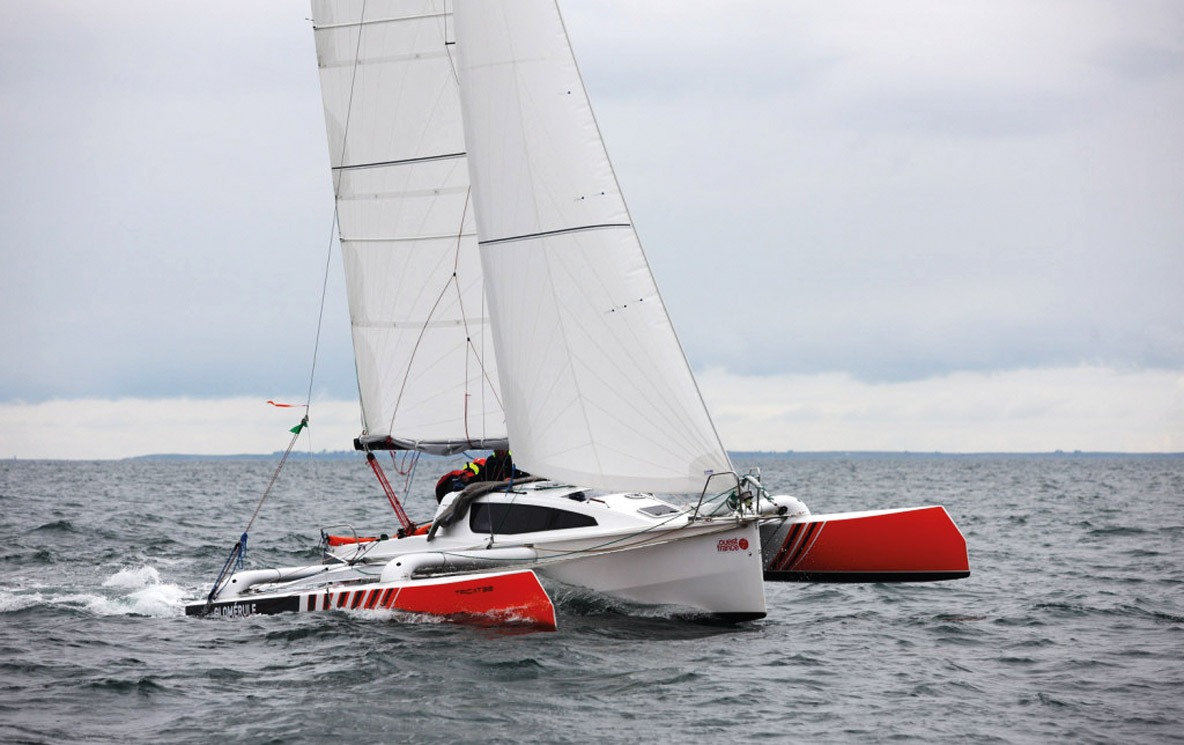
The Tricat 30 offers all the comfort a crew of up to 6 could wish for, thanks to a very comfortable central hull - panoramic saloon - and a vast cockpit. Powerful, the Tricat 30 remains easy to handle for the whole family or on your own. In port, it folds easily while afloat to limit its beam to 11’6” (3.50 m). Its structural stiffness allows it to have exceptional speed potential: the 30 has already been caught at over 20 knots. And you’ll be reaching these speeds all the more easily as the mainsail is now bigger thanks to a new rig. At least ten Tricat 30s have been delivered since 2016. An excellent platform for semi-offshore cruising.
Builder: Tricat Length: 30’2”/35’9” (9.2/10.9 m) Beam: 11’6”/23’ (3.5/7 m) Light displacement: 5,180 lbs (2,35 t) Draft: 19”/5’3” (0.48/1.6 m) Mainsail: 425/484 sq ft (39.5/45 m²) Jib: 237/264 sq ft (22/24.5 m²) Engine: 10/15 HP outboard Price: € 174,833 ex-tax
CORSAIR 970
The dna of the corsair 31 is still plain to see….
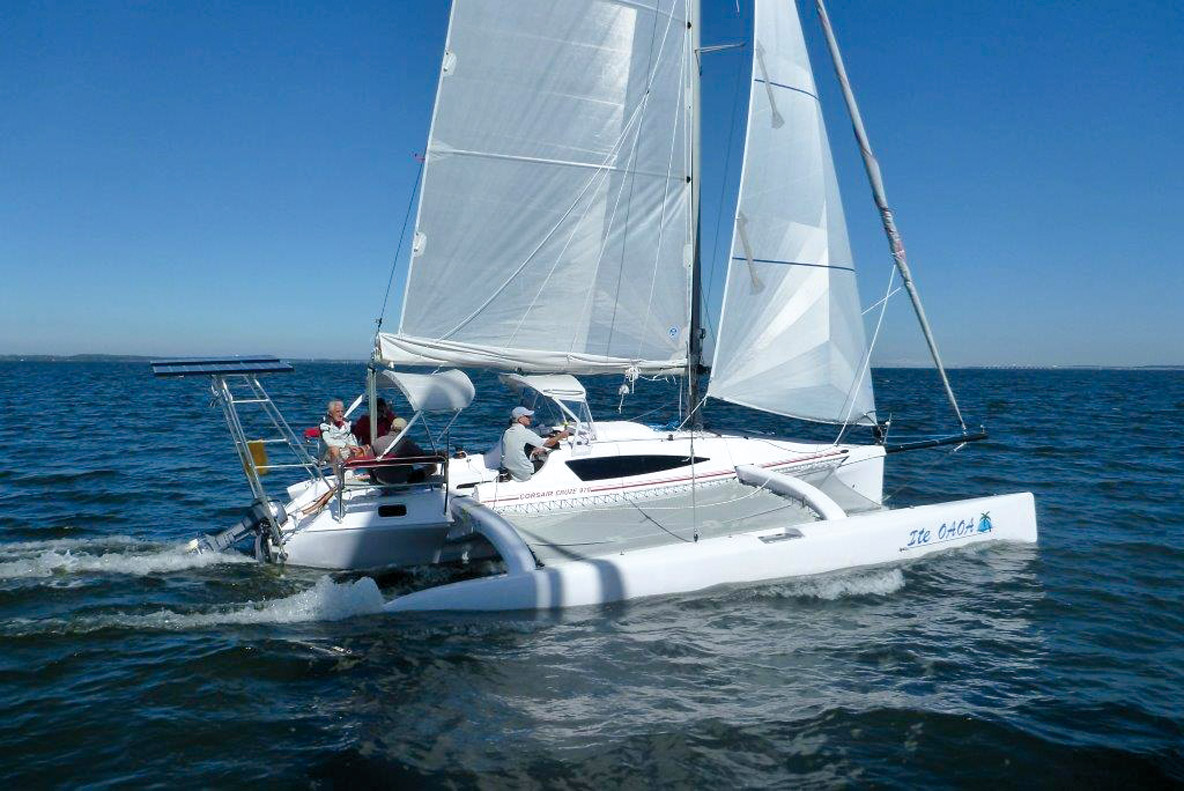
The Corsair 970 – also known as the Cruze 970 - took over from the Corsair 31 more ten years ago now. Fans of folding trimarans know how much the Corsair 31 left its mark on people’s minds. With more than 300 examples built, it is one of the yard’s best-sellers. The Corsair 970 didn’t take any unnecessary risks: it was really an evolution of the Corsair 31, but with greater comfort on board, more in line with the Corsair 37. On board the 970, there’s about 15% more space than on the 31 and notably, much better headroom, as you can now stand upright in the saloon... But this comfort in no way hinders the seakeeping qualities of the Cruze 970, which remains a true Corsair trimaran. The Sport, and especially the Carbon, versions are obviously higher performing. It goes without saying that the 970 is foldable, using the system so highly prized by the yard.
Builder: Corsair Marine Construction: glass/polyester/PVC sandwich Length: 31’10” (9.7 m) Beam: 22’7”/8’4” (6.88/2.55 m) Light displacement: 4,800 lbs (2,18 t) Draft: 18”/6’11” (0.45/2.1 m) Mainsail: 382/452 sq ft (35.5/42 m²) Genoa: 188/247 sq ft (17.5/23 m²) Spi: 872/925 sq ft (81/86 m²) Engine: 10 to 15 HP outboard
DRAGONFLY 32
Long live those wave-piercing floats.
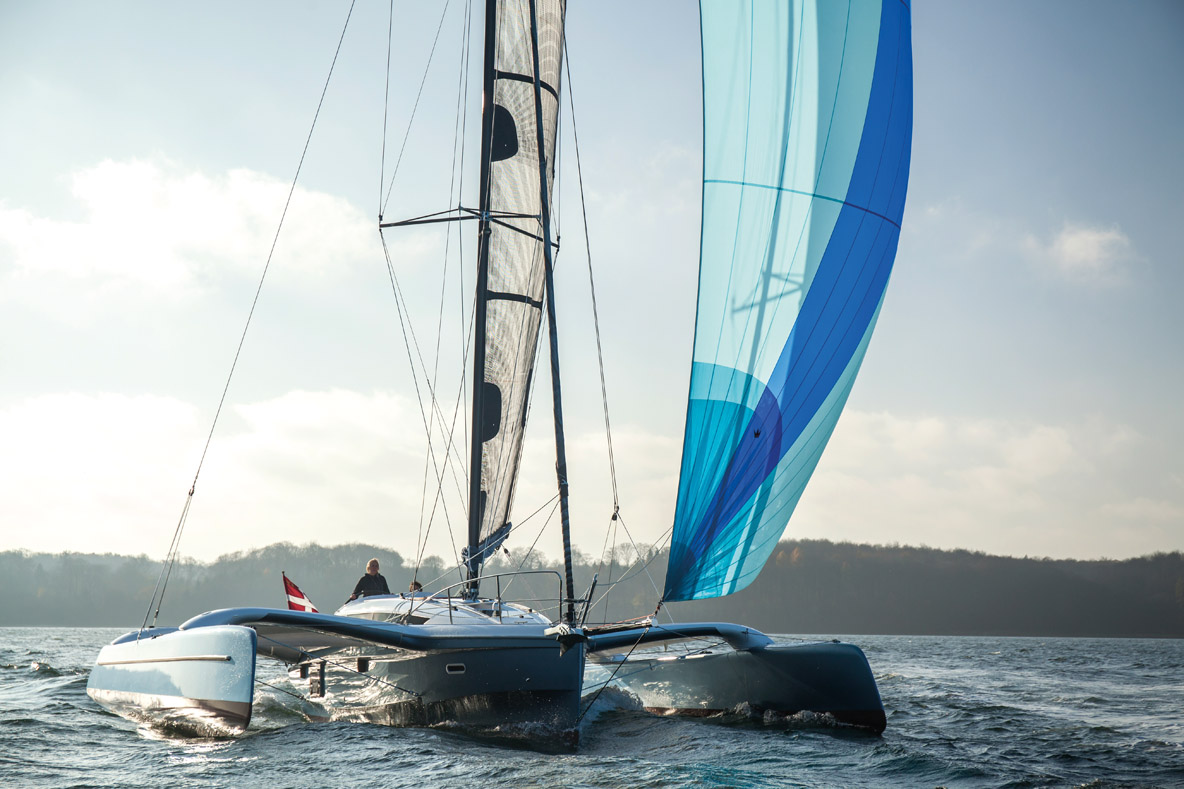
The first-generation Dragonfly 32 marked the history of Quorning Boats with more than 50 examples built. The Evolution replaced the Supreme version in 2019, with 20% larger floats and a more powerful rig. The stretched underwater hulls of the floats, the higher volume and the inverted bows are a real plus with a cross-sea or for sporty sailing. Admittedly, at the same price, the Dragonfly 32 Evo offers a third of the living space of an honest 40-foot catamaran, but what are we looking for when we choose this boat? A ...
Subscribe to Multihulls World and get exclusive benefits.
Tags :
- 2023 Sail Buyer s Guide
Did you like this article ?
Share this article
Most-read articles in the same category.

Who's Who - Nigel Irens: A wonderful, self-taught naval architect
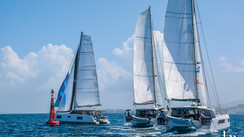
A Wonderful Nautitech Gateway - An Owners’ Meet Up in Martinique
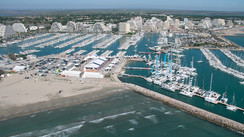
International Multihull Show - The unmissable get-together for multihull fans
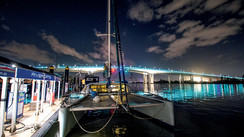
The photographer's eye - Rivergate Marina, Brisbane, Australia: Customs Clearance!
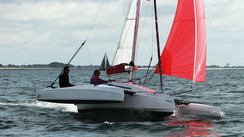
2023 Sail Buyer's Guide - Multihulls from 20 to 30 feet
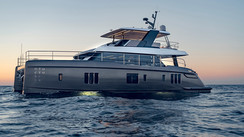
2023 Power Buyer’s Guide - 60 to 70 feet
Articles from the same story.
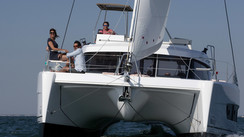
2023 Sail Buyer's Guide - Multihulls from 40 to 45 feet
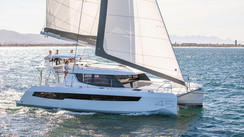
2023 Sail Buyer's Guide - Multihulls from 45 to 50 feet
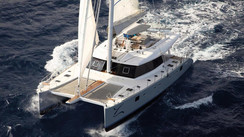
2023 Sail Buyer's Guide - Multihulls from 60 to 70 feet
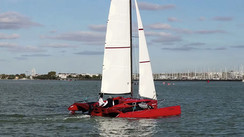
2023 Sail Buyer's Guide - Forever green
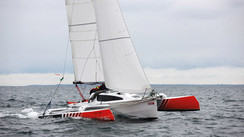
2023 Sail Buyer's Guide - Multihulls from 50 to 60 feet
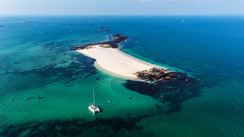
2023 Sail Buyer's Guide
What readers think.
Post a comment
No comments to show.
Follow us on
Vous avez ajouté " " à vos favoris., vous avez supprimé " " de vos favoris., in order to add this article to your favorites, please sign in..
DRAGONFLY Trimarans User Forum
International Dragonfly Trimarans User Forum
Skip to content
- Home Forum Index DF1200 DF1200 Motor/Equipment/Electrics
Corsair 37 or Dragonfly 35: Which Is Better for Blue Water P
Post by JoeClark » Sat 11 Nov 17, 9:39
Post by Double Horizon » Mon 13 Nov 17, 2:40
Return to “DF1200 Motor/Equipment/Electrics”
- General Dragonfly Trimarans User Forum
- ↳ General
- ↳ HULL issues concerning all DFs
- ↳ Rig/Sail issues concerning all DFs
- ↳ Motor/Equipment/Electrics issues concerning all DFs
- ↳ E V E N T S
- ↳ DF25 General Topics
- ↳ DF25 Hull
- ↳ DF25 Rig/Sails
- ↳ DF25 Motor/Equipment/Electrics
- ↳ DF800 General Topics
- ↳ DF800 Hull
- ↳ DF800 Rig/Sails
- ↳ DF800 Motor/Equipment/Electrics
- ↳ DF28 General Topics
- ↳ DF28 Hull
- ↳ DF28 Rig/Sails
- ↳ DF28 Motor/Equipment/Electrics
- ↳ DF920 General Topics
- ↳ DF920 Hull
- ↳ DF920 Rig/Sails
- ↳ DF920 Motor/Equipment/Electrics
- ↳ DF1000 General Topics
- ↳ DF1000 Hull
- ↳ DF1000 Rig/Sails
- ↳ DF1000 Motor/Equipment/Electrics
- ↳ DF32 General Topics
- ↳ DF32 Hull
- ↳ DF32 Rig/Sails
- ↳ DF32 Motor/Equipment/Electrics
- ↳ DF35 General Topics
- ↳ DF35 Hull
- ↳ DF35 Rig/Sails
- ↳ DF35 Motor/Equipment/Electrics
- ↳ DF1200 General Topics
- ↳ DF1200 Hull
- ↳ DF1200 Rig/Sails
- ↳ DF1200 Motor/Equipment/Electrics
- ↳ DF40 General Topics
- ↳ DF40 Hull
- ↳ DF40 Rig/Sails
- ↳ DF40 Motor/Equipment/Electrics
- Home Forum Index
- All times are UTC
Powered by phpBB ® Forum Software © phpBB Limited
No responsibility is accepted by the publisher of these web pages for contents submitted by other people! All Trademarks and Copyrights shown or mentioned on this website are herewith acknowledged. © 2001-2023 Bo Wetzel
Privacy | Terms
Provence Online Shopping: Beautiful things direct from Provence
- BOAT OF THE YEAR
- Newsletters
- Sailboat Reviews
- Boating Safety
- Sailing Totem
- Charter Resources
- Destinations
- Galley Recipes
- Living Aboard
- Sails and Rigging
- Maintenance

3 Small, Sporty Trimarans
- By Herb McCormick
- Updated: March 5, 2009
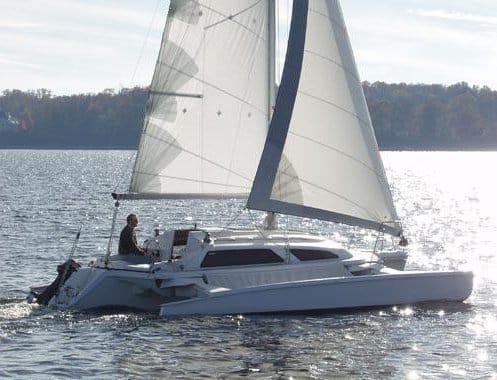
When it comes to cruising multihulls, the trimaran often plays second fiddle. The main reason is the sheer popularity and growth of cruising catamarans, thanks in no small part to the charter trade. But trimaran sailors have come up with a rather amusing handle for their beloved vessels: a cat-and-a-half. There’s some truth to the name.
If part of the reason one goes cruising is for a quality sailing experience, it’s hard to beat a well-executed tri. With shallow draft, they can easily poke into the shallows or up on a beach away from the madding crowd. And many midsize trimarans can be folded up and trailered for a cruise to Maine or the Florida Keys. As one tri sailor put it, “It’s sweet to go to windward at 65 miles per hour.”
I had the opportunity to sail a trio of cruising trimarans over a variety of waters and with an array of avid sailors and builders. Interestingly, the respective boats and venues-the Telstar 28 on Chesapeake Bay, the Corsair 31 on Massachusetts’ Buzzards Bay, and the Dragonfly 35 in the U.S. Virgin Islands-seemed especially well suited for one another. All boats are compromises, and trimarans are no different: Unlike cruising cats, which can handle those hefty payloads and multiple staterooms, tris are limited in space and accommodations by the parameters of their layout. But when all was said and done, I came away with a fresh appreciation for the viability of a relatively compact tri as a terrific, even exhilarating, coastal cruiser. Here’s what I discovered.
Telstar 28: Bred on Chesapeake Bay
The result of an exacting evolutionary process, the Telstar 28 is the proud creation of expatriate British multihull designer Tony Smith, who’s been testing and refining his notion of what makes an appealing triple-hulled pocket cruiser for almost four decades. His Chesapeake Bay-based business, Performance Cruising Inc., is very much a family affair, with his wife, kids, and son-in-law all prominently involved.
Smith launched the first incarnation of the Telstar, a 26-footer, in England in the early 1970s, eventually building 300 of them before relocating to this side of the Atlantic. A 1981 fire put the Telstar on hold while Smith shifted his emphasis to producing the Gemini line of cruising cats. But earlier this decade, he brought the trimaran out of mothballs and began to fine-tune his original vision, going through more than half a dozen prototypes before he was satisfied that he had a boat worthy of the marketplace.
For Smith, a hard-core multihull racer in his youth, the tug toward performance has always been strong. But with the Telstar 28, he wanted a boat that would be fun and fast under both sail and power but that could also serve for weeks at a time as a floating home, possessing features and systems that are foolproof and strongly engineered but dead simple to apply. A foldable, trailerable cruising boat sounds good, but it’s much less so if operating it is a chore for the owner.
And so Smith and his son, Neil, went to work, experimenting with rig size, outrigger shapes, and engine horsepower. They fussed with float deployment, steering systems, construction techniques, and numerous ways to raise and lower the mast. The goal was straightforward: a boat that sailed simply and well and that a couple or small family could enjoy. When he had everything just so, Smith made a couple of trips to Florida, by himself, trailering a Telstar. He launched and retrieved the boat, put the mast up and took it down, and went sailing, all alone. Only then was the reincarnated boat ready for prime time.
The revamped Telstar, now 28 feet long, has been in production for several years, and nearly 70 new boats have been built. On a visit last August to the boatyard on the Chesapeake’s Back Creek, Will Hershfeld, Smith’s son-in-law, gave me the tour.
Smith is especially proud of the arrangements for folding and deploying the outriggers and for stepping and striking the deck-stepped spar, both of which a lone sailor can do almost effortlessly in no time flat. The outriggers can be deployed or retracted on the trailer or in the water utilizing an ingenious rotary-pivot joint that reduces the maxed-out 18-foot beam to a mere 8 feet 6 inches in collapsed mode. The mast can be winched up (or lowered) from the cockpit via a set of four A-frames that work in tandem to support the stick during the evolution. Neither the sails nor the boom need to be removed for the mast’s raising or lowering, which maximizes the efficiency of the task.
Somewhat less heralded but also extremely clever is the tiller/outboard connection. With a single pin in place, the tiller and engine operate in tandem for optimum steering control under power. Under sail, the pin can be removed and the engine raised, thus linking the tiller directly to the rudder. The standard engine, incidentally, is a 20-horsepower Honda that scoots the boat along at a tidy 7 to 8 knots. A 50-horsepower Honda that will reportedly deliver 15 knots of boat speed is an option to form a sail/power version of the boat.
Belowdecks, the immediate and biggest surprise is the spaciousness of the central hull, particularly the 6-foot standing headroom. A large head compartment is forward of the saloon, which includes a pair of 6-foot-long settees flanking a folding dinette. With a series of slats in place down the main thoroughfare, one of the settees can be converted to a generous double berth. On either side of the companionway, a small galley with a two-burner stove and a simple navigation area addresses the essentials for dining and piloting.
Thanks to vacuum-bagged infusion for the outrigger assembly and a foam-core laminate in the main hull, the Telstar 28 weighs in at an almost unbelievable 3,000 pounds. The working sail area, augmented by the mainsail’s generous roach, measures 524 square feet. The power-to-weight ratio seemed promising, and I was eager to see how it translated to speed under sail.
The Chesapeake was in a cooperative mood as we powered out of Back Creek and set the main and 150-percent genoa in 12 to 15 knots of true wind. Sailing closehauled at about 30 degrees apparent, the boat slid along respectably at 6 to 7 knots with a well-balanced, fingertip touch to the tiller. We threw in a few tacks, and a couple of things were quickly apparent. First, the combination of formidable side decks along the main hull and fabric trampolines (not nets) between the outriggers made for an extremely dry ride, something I wasn’t expecting. But the 50-horsepower outboard on our test boat was a slight burden, dragging a bit, even when raised, on starboard tack. Our performance spiked when we flipped over to port and the propeller completely cleared the water.
The Telstar really came alive when we set the 400-square-foot screacher off the sprit. At 50 degrees apparent, we bettered 10 knots, and when we fell off to a beam reach, we topped off at a very lively 13.2 knots. A small chop was building on the bay, however, and it definitely slowed us down slightly, as the light boat just didn’t have the inertia to muscle through the wavelets. It’s a small quibble: I was already impressed. This child of the Chesapeake-an ideal cruising ground for this quick, shallow-draft trimaran-had displayed plenty of gumption on its home waters.
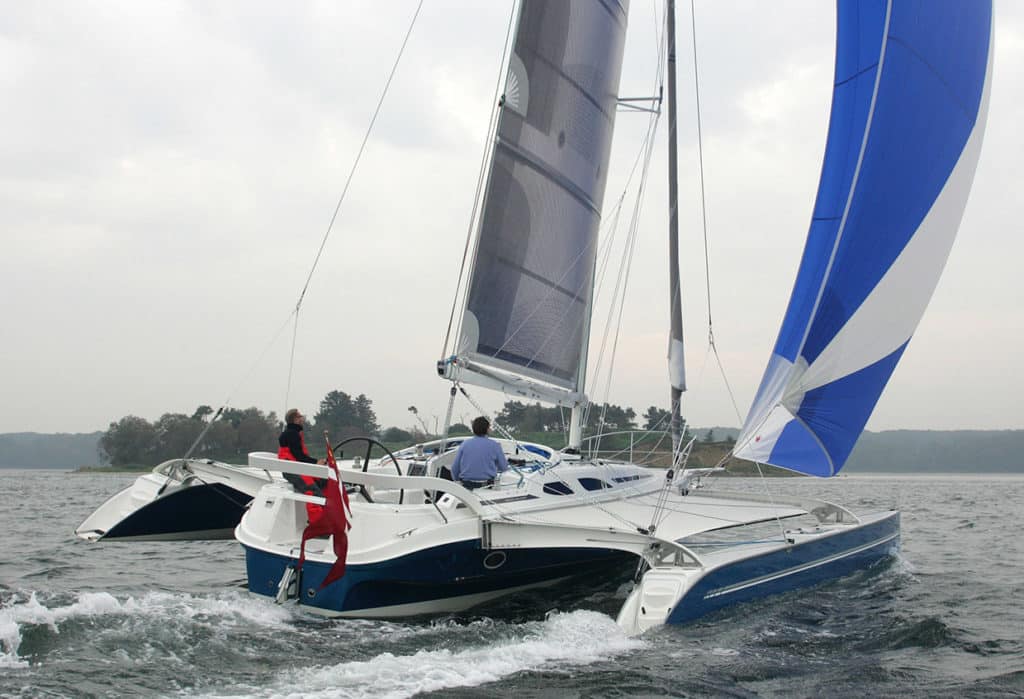
Dragonfly 35: A Trade-Wind Rocket
The marvelous Danish-built Dragonfly 35 stands apart from the other pair of trimarans in this roundup on multiple fronts, the most notable of which are size, cost, and accommodations.
In the protected harbor of Great Cruz Bay, in the U.S. Virgin Islands, I met Dr. James Clayton, the proud owner of hull number 11 in the Dragonfly 35 run. Looking for a bit faster ride, with roomier accommodations and better sun protection, Clayton had moved up to the 35-footer from the 33-foot Dragonfly 1000, a boat that he loved and which is no longer in production. The 35 comes in two versions, Touring and Ultimate, the latter, which Clayton owns, boasting a slightly taller carbon-fiber mast with exotic, high-tech Vectran/Technora sails and strong, lightweight standing and running rigging.
Clayton obviously enjoys a boat that performs well, but he also likes creature comforts, and he’s loaded the boat with a variety of options, including an Andersen 46ST electric winch for mainsail hoisting, a watermaker, a three-bladed folding prop (instead of the standard two-bladed version), a diesel heater, and even a bow thruster, which is employed via a “garage door” that lies flush to the hull when not in use.
It seemed odd to choose the high-tech version of the boat and then load it up (and weigh it down) with such a long list of amenities. But Clayton had good reasons for his choices. The bow thruster proves very handy in controlling the fine, light bow in close quarters on windy days, and the heater was welcome during a cruise through Nova Scotia.
The Dragonfly 35 employs the builder’s Swing Wing system to fold the amas, but with a 12-foot-10-inch beam when the outriggers are retracted (down from a graceful, sweeping 26 feet 11 inches in sailing mode), trailering isn’t an option. Still, the folded boat will fit into a standard marina slip.
The accommodation plan doesn’t enjoy the interior volume of a contemporary 35-foot monohull, but it’s a clean, modern design that makes excellent use of the space. There are generous double berths on either end: a V-berth in a dedicated cabin forward, and another double beneath the cockpit. An enclosed head is situated forward of the main cabin, which has 6-foot-4-inch headroom and features a long settee to port, a cozy but handy navigation station at the foot of the companionway, and a lengthwise galley to starboard, with an abundance of counter space and good storage. The Volvo diesel, with saildrive, is located in a dedicated aft compartment.
The deck layout and corresponding sailhandling systems are also extremely well executed. A retractable carbon sprit in a sealed, dedicated tube is just forward of the recessed Facnor headsail-furling gear. Four flexible 9.5-amp Sunware solar panels do a fine job of topping off the house batteries. The single-line reefing system is led aft to the cockpit, an extremely comfortable space with a large bimini overhead and a rounded helmsman’s backrest aft. The traveler is mounted on a central beam just forward of the helmsman, while the double-ended mainsheet is close at hand.
There’s good visibility for the wind and speed instruments mounted over the companionway, and clear sight lines exist to the Raymarine chart plotter mounted on the rear of the coachroof. A portable beam can be removed to provide walk-through access to the transom and the aft deck shower. Finally, each of the amas is equipped with a rear hatch, through which can be stashed a pair of 17-foot sea kayaks. The Dragonfly 35 can most definitely be classified as a sport utility vehicle.
We sailed the boat on a day of moderate easterlies blowing at 12 to 14 knots. Upwind, at roughly 30 degrees apparent, the boat made anywhere from 7.9 to 8.4 knots, and as we eased sheets and bore off, the speed ratcheted up accordingly, to 8.5 to 9 knots. Frankly, I was somewhat disappointed in the sheer speed (Clayton has made more than 18 knots in breeze ranging in the 20s), but as I mentioned, we were carrying a boatload of extras. It was a choppy day, but the Dragonfly was in no way hampered by the seaway. The V-sectioned central hull cleaved nicely through the waves without hobbyhorsing, providing a smooth, purposeful motion and leaving the smallest of wakes. And steering the boat was a real joy, with the Jefa rack-and-pinion steering system offering true fingertip control. I’d love to sail a 35 in big breeze.
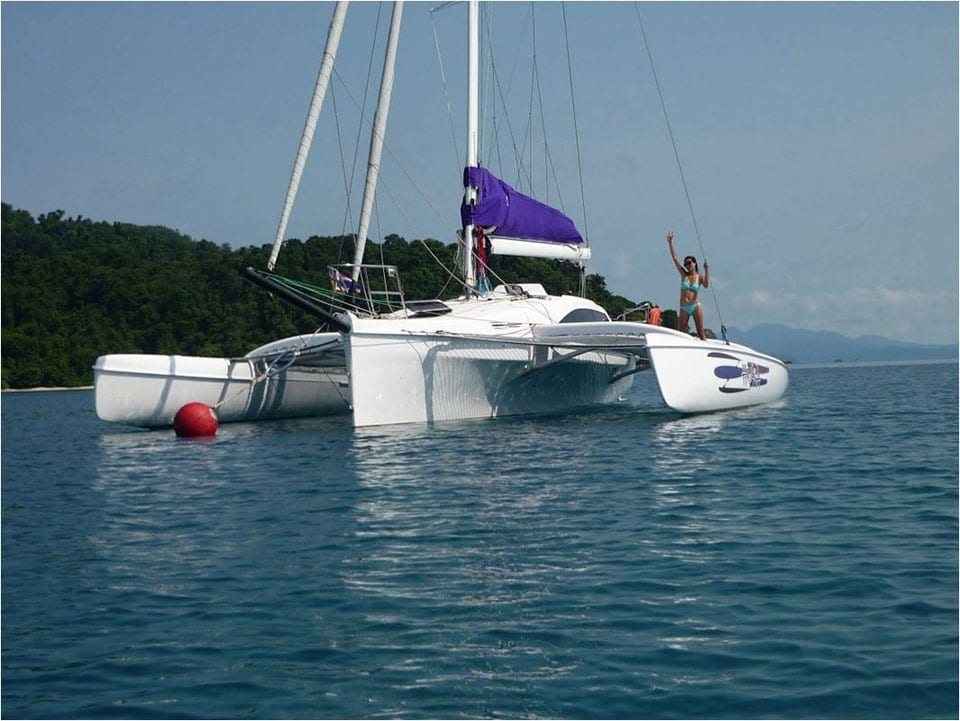
Corsair 31CC: Island Cruiser
The final stop on my Magical Trimaran Mystery Tour was Buzzards Bay, Massachusetts, the site of last summer’s annual Corsair Trimaran Nationals. That event was a fun, lively occasion with lots of action on the water and fun off it. No sailors, it seemed, were more excited about their boat than Charles and Hilary Badoian, who were spending the New England summer living aboard and cruising their Corsair 31, Ship o’ Fools.
The Corsair 31, originally designed by Ian Farrier and updated in recent times by Corsair Marine, has been in production now for well over a decade, with nearly 300 of them built. Originally produced in Australia, today they’re built in Vietnam. The 31 has been tweaked considerably from its inception, and it’s now available in four different models: the 31UC (Ultimate Cruiser), the 31AC (Aft Cockpit), the 31CC (Center Cockpit), and the 31-1D (One Design).
The One Design version comes with streamlined accommodations and a carbon-fiber rig with a retractable bowsprit as well as racing sails and modified foils, but it should be noted that every new Corsair 31-all of which now feature rotating masts-can be ordered with carbon rigs and retractable sprits.
The Badoians had been wandering through the Elizabeth Islands, southeastern Massachusetts, and Cape Cod for several months, and while they enjoyed the liveaboard lifestyle, they were also conducting, from their compact underway home, their full-time business as event planners. They’d come to the rendezvous to meet like-minded sailors, compare notes, and enjoy watching the racing from the deck of their own 31CC. Former owners of a Catalina 30, they’d made the switch to multihulls and were certain of one thing: After the easy speed and shoal draft of their trimaran, they weren’t going back.
Their 31-footer was actually an older model, built in 1996, but there are many similarities that have carried on through time. The most important was the basic layout of the center-cockpit version, which still features a V-berth forward, an enclosed head in the central cabin-along with a settee, a small dinette, and a surprisingly workable galley-and a second separate cabin aft, which is ideal for guests or storage.
The deck layout is also conducive to efficient shorthanded sailing, with the traveler and mainsheet well aft, easily within reach of the helmsman yet behind the tiller, making tacking and jibing a hassle-free maneuver. (In the Aft Cockpit version, the traveler is forward of the tiller.) The Badoians also were enamored of the roller-furling boom, another item that’s been passed down the line. Reefing, they said, was a snap.
The couple said they regularly enjoyed boat speeds ranging from 9 to 12 knots on Ship o’ Fools, which isn’t equipped with a bowsprit or a screacher. Unfortunately, on the day I sailed with them, the wind hovered between 5 to 8 knots, with only an occasional puff of around 10 knots. Still, under main and genoa, when it blew 5 knots, we made 5 knots. And when it topped 10 or so, we eased along at an effortless 7.5. In the flat water, steering from well outboard to get a clear view of the telltales, the sensation was almost more akin to flying than to sailing.
Corsair dealer Bob Gleason, whose Massachusetts brokerage firm, The Multihull Source, was hosting the Corsair Nationals, said that newer models far exceed the performance potential of older boats, thanks to a slightly taller rig, the aforementioned standard rotating mast, and the addition of a screacher mounted on a pole that retracts into a tube mounted in the forward cabin.
Gleason said the rotating masts also aid in raising and lowering the spar, as the outboard shrouds aren’t connected to the main hull; a pair of temporary shrouds are used to facilitate the operation. The amas of the Corsair 31 are also easily retracted and deployed via the longstanding Farrier Folding System, which hinges on just four bolts. The boat can be set up or put away by an experienced sailor in about half an hour.
The Badoians at some point may upgrade to a larger trimaran, but for now, they couldn’t be happier with their Corsair 31.
One of my fondest sailing dreams is to someday hop aboard a fast, zippy multihull, skip across the Gulf Stream from Florida to the Bahamas, and spend a long winter poking into every nook and cranny I can find. Without reservation, I’d happily take the Telstar, Dragonfly, or Corsair on such an adventure. That said, my time aboard left me with several observations about each boat.
The Telstar 28 is an extremely well-reasoned boat, but it was also first conceived in the 1970s, and unless you find beauty in utility, the profile is a bit boxy and certainly not as sexy as the other boats in this roundup. But with a price tag well under $100K, especially considering its portability in these days when moorage is at a premium, it’s also a good bargain.
The Dragonfly 35 is the gold standard in this collection, and given its $370K cost, it certainly should be. It’s foldable, yes, but not trailerable, and for some sailors in well-populated locales, finding a place to permanently moor it may be an issue. However, it’s also a solid, superbly crafted vessel that with its systems and potential for extended sailing, will take one anywhere in high style.
The Corsair 31 tilts toward the high-performance end of the spectrum, and for some sailors, it may be a handful. But there are options galore in the four respective versions, and other sailors will relish the competitive opportunities with a vessel that also provides more than reasonable accommodations for coastal forays. It may be the most versatile boat of the three.
In short, when buying any boat, it’s ideal to have choices. And if you’re in the market for a small multihull-no matter what your budget or intended plans-with this segment of midsize trimarans, there’s an excellent selection.
Herb McCormick is a Cruising World editor at large.
LOA 27′ 6″ (8.38 m.) LWL 26′ 3″ (8.00 m.) Beam (amas out/in) 18′ 0″/8′ 6″ (5.49/2.59 m.) Draft (board up/down) 1′ 0″/4′ 3″ (0.30/1.30 m.) Sail Area (100%) 524 sq. ft. (48.7 sq. m.) Displacement 3,000 lb. (1,361 kg.) Water 30 gal. (113.5 l.) Fuel 12 gal. (45.4 l.) Engine Honda 20-hp. outboard (Honda 50-hp. optional) Designer Tony Smith Price $89,500 Performance Cruising (410) 626-2720 www.performancecruising.com
Dragonfly 35 Touring
LOA 35′ 0″ (10.68 m.) LWL 34′ 5″ (10.50 m.) Beam (amas out/in) 26′ 11″/12′ 10″ (8.20/3.90 m.) Draft (board up/down) 1′ 10″/6′ 3″ (0.55/1.90 m.) Sail Area 904 sq. ft. (84 sq. m.) Displacement 8,598 lb. (3,900 kg.) Water 37 gal. (140 l.) Fuel 21.1 gal. (80 l.) Engine Volvo 30-hp. diesel Designers Borge and Jens Quorning Price $370,600/$404,700 Dragonfly Sailboats USA (908) 232-7890 www.trimarans.com
LOA 30′ 10″ (9.40 m.) LWL 30′ 0″ (9.15 m) Beam (amas out/in) 22′ 5″/8′ 2″ (6.84/2.5 m.) Draft (board up/down) 1′ 4″/5′ 6″ (0.41/1.68 m.) Sail Area (100%) 647 sq. ft. (59.9 sq. m.) Displacement 3,850 lb. (1,747 kg.) Water 25 gal. (94 l.) Engine 9.9-hp. outboard Designer Ian Farrier/Corsair Marine Price $151,000
Corsair Marine (619) 585-3005 www.corsairmarine.com
- More: 2001 - 2010 , 21 - 30 ft , 31 - 40 ft , Boat Gallery , Coastal Cruising , corsair marine , day sailing , dragonfly , multihull , racer / cruiser , Sailboat Reviews , Sailboats
- More Sailboats
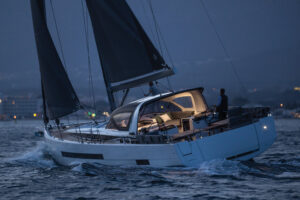
Sailboat Review: Jeanneau Yachts 55
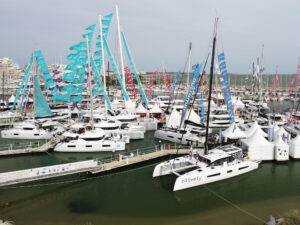
Modern Multihulls: The Future’s Electric

A Gem in New England

Thinking of a Shift to Power?

A Big, New World

Cruising World On Board: Windelo 50

Into the Mystic: A Pacific Northwest Adventure

How to Ride a Wave
- Digital Edition
- Customer Service
- Privacy Policy
- Email Newsletters
- Cruising World
- Sailing World
- Salt Water Sportsman
- Sport Fishing
- Wakeboarding
Your source for the latest news on yachts, boats and more. Read through our articles to find out how to compare boats and find the right fit for you!
New Trimarans: which are the best ones
Jun 09, 2021
less than a min
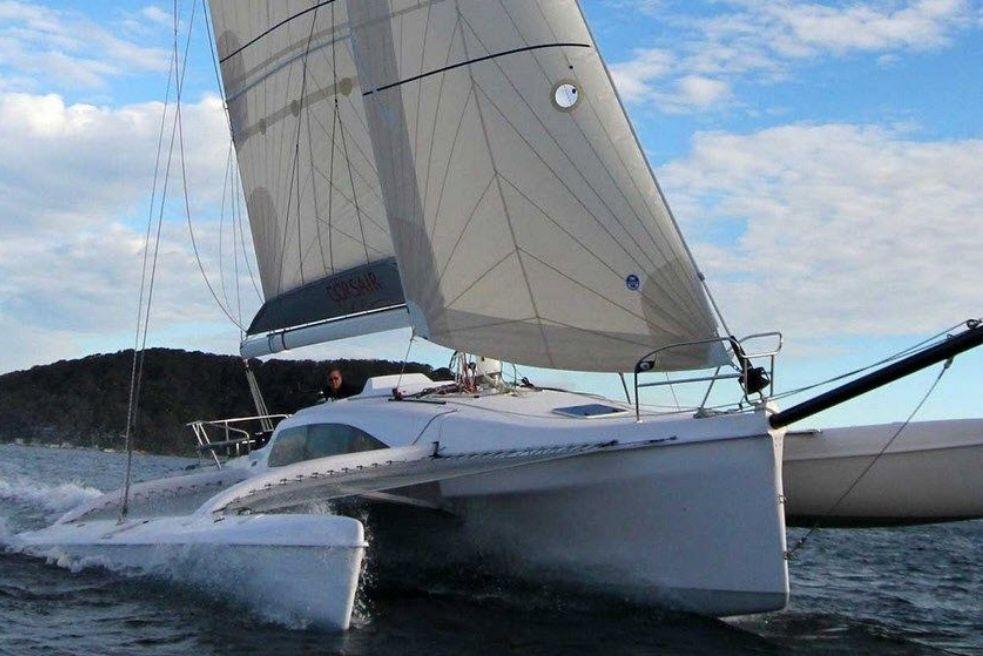
Trimarans are multi-hulls boats with three of them in parallel. They are considered unsinkable thanks to their geometry and shape, but also quite versatile and sporty. In addition, trimarans have a very futuristic look and an ingenious design which makes them one of the most unique vessels to sail in.
The new trimarans launched in 2021 have more interesting features and definitely more charm than anything you have seen before. Here are our favorites.

Neel 43 is one of the best new trimarans from the French Neel Trimarans company. It features a saloon, a galley, and two cabins for two people on top, and two single cabins on each bow. In addition, the cockpit and the saloon are connected through sliding doors which allows the spaces to flow within one another and yet maintain their own identity. This trimaran is 13 meters long and costs about €329,800.

Pulse 600 is one of the best racing new trimarans of 2021. It is seen as a big and yet quite an affordable vessel that is very fun to sail. Its multiple hulls are made of lightweight reinforced materials, very sleek and elegant. It features an open cockpit and can accommodate up to 4 people. Also, it can be sailed single-handed without any effort.

Rapido 60 is a new trimaran with a futuristic look. It reaches up to 18.1 meters with a beam of 11.7 meters and a draft of 0.75 meters. This boat has an average headroom of 2.1 meters and a mast height above water that reaches 25.3 meters. In addition, Rapido 60 has a 125 square meter mainsail and a 71 square meter Solent. Also, a 25 square meter storm sail is included, with a 130 square meter reacher and a 225 square meter asymmetric spin.
Dragonfly 28

The Dragonfly 28 offers a unique design that comes with not only one but two great new trimarans: the 28 Touring version and the Dragonfly 28 Performance Trimaran. The Performance Dragonfly 28, on the other hand, also comes in two versions, the Inshore and Offshore racer, perfect for people who love sports and adventure.
This is a very easy to sail trimaran, perfect for sailing solo or in company, as this boat can accommodate up to 5 people. Most importantly, this trimaran looks like a modern piece of art thanks to the elegant design and white shiny paint.

Corsair 37 is considered an unsinkable new trimaran that is not only secure but also super comfortable. It is made of built-in carbon hulls that can reach high speeds. The most unique thing about this trimaran is that it has been used in expeditions in the Arctic.
For more news and information on new trimarans, as well as other multihulls or monohulls, yachts, and sailboats, check out the rest of our articles in TheBoatDB blog. Also, visit the platform where you can browse multiple models and even benchmark and compare a few of them together. You can find out the lengths, displacements, interior, images, and more specifications of trimarans on our full boat database.
You might like these too

Sailboat or Motorboat – Learn the pros and cons lg ...
Aug 24, 2022


Types of Catamaran Boats: Sailing, Power, and Luxury Catamarans lg ...
Feb 10, 2023

Which is better a wooden boat or fiberglass boat lg ...

What are the main types of sail rigs for sailboats lg ...

Which is the Best Economical Catamaran lg ...
Oct 04, 2021

What is a Chine on a Boat lg ...
Oct 01, 2021

Corsair 880 Trimaran 2021 Review by SAIL Magazine
I’ve often written in boat reviews over the years that pretty much any boat sails well in 15 knots of breeze (typically as a word of explanation as to why sail trials done in drifting conditions are as relevant as those done in a small gale). However, it recently occurred to me there is an exception to this rule, and that is aboard a performance trimaran like the Corsair 880.
– Adam Cort from SAIL Magazine

Despite the boat’s go-fast looks, complete with a drop-dead gorgeous tumblehome bow (flared to help keep the spray down underway), there’s standing headroom in the narrow but well-configured galley and saloon, and berth space for as many as five. Make no mistake, the Corsair is a legitimate pocket cruiser (it never ceases to amaze me the kinds of amenities that can be fit into a well-designed trimaran) albeit a pocket cruiser that gets you from one anchorage to the next in record time. Talk about a fun way to go gunkholing!

Share This Story, Choose Your Platform!
Related posts.
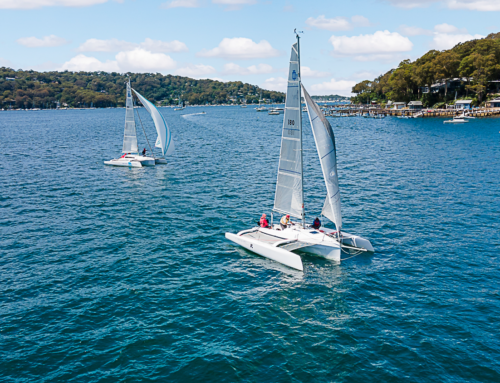
Corsair & Seawind Pittwater Regatta 2022
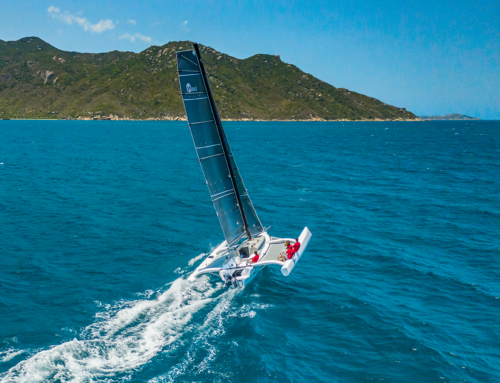
Seeing Triple – Multihull Trimarans Redefine Sailing With Speed & Agility

The current situation at Corsair Marine

Trimaran Buying Tips: Choosing a trimaran that fits your needs
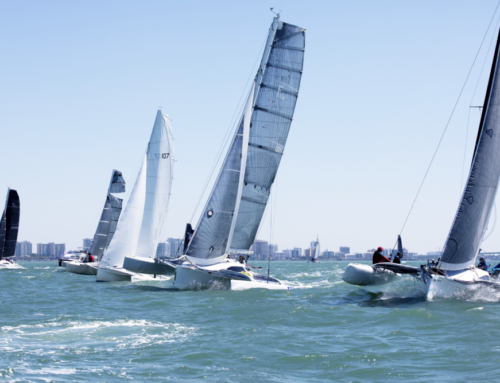
The Corsair Nationals 2021 – Once again a huge success to the trimarans community!
- New Sailboats
- Sailboats 21-30ft
- Sailboats 31-35ft
- Sailboats 36-40ft
- Sailboats Over 40ft
- Sailboats Under 21feet
- used_sailboats
- Apps and Computer Programs
- Communications
- Fishfinders
- Handheld Electronics
- Plotters MFDS Rradar
- Wind, Speed & Depth Instruments
- Anchoring Mooring
- Running Rigging
- Sails Canvas
- Standing Rigging
- Diesel Engines
- Off Grid Energy
- Cleaning Waxing
- DIY Projects
- Repair, Tools & Materials
- Spare Parts
- Tools & Gadgets
- Cabin Comfort
- Ventilation
- Footwear Apparel
- Foul Weather Gear
- Mailport & PS Advisor
- Inside Practical Sailor Blog
- Activate My Web Access
- Reset Password
- Customer Service

- Free Newsletter

How to Perform Your Own Pre-Buy Inspection
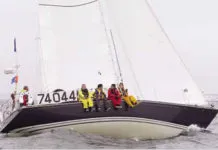
C&C 40 Used Boat Review
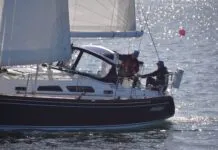
Sabre 386 Used Boat Review
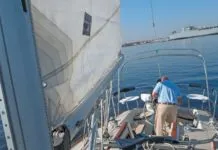
What You Can Learn on a Quick Test Sail

Preparing Yourself for Solo Sailing

Your New Feature-Packed VHF Radio

Preparing A Boat to Sail Solo

Solar Panels: Go Rigid If You have the Space…

Ground Tackle Inspection Tips

Shoe Goo II Excels for Quick Sail Repairs

When Should We Retire Dyneema Stays and Running Rigging?

Rethinking MOB Prevention

An Unusual Sailboat Shines a Light On A Sustainable Future

Is It Time to Get an Electric Dinghy Motor?
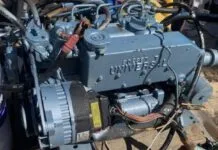
Worship Your Universal M-Series Diesel With the Marinized Kubota Block

Taking Care of Your 12-Volt Lead-Acid Battery Bank

Battle of the Teak Cleaners — Snappy Teak-Nu vs. Star Brite

New Seacocks for the Offshore Sailor

Bottom Paint Care

Quick and Safe Sail Cleaning

Are E-bikes Worth the Extra Weight and Cost?

How to Handle the Head

The Day Sailor’s First-Aid Kit

How to Select Crew for a Passage or Delivery

Re-sealing the Seams on Waterproof Fabrics

Waxing and Polishing Your Boat

Reducing Engine Room Noise

Tricks and Tips to Forming Do-it-yourself Rigging Terminals

Marine Toilet Maintenance Tips

Learning to Live with Plastic Boat Bits
- Sailboat Reviews
Corsair F-31
Ian farrier's latest fold-up trimaran is bigger and fasterthan the popular f-27. construction is generally good, though there havebeen some problems, and the wiring could be neater..
Like the blips on a heart monitor, Corsair Marine has experienced several peaks and valleys since our review of the Corsair F-27 (September, 1990), including the sale of the company by its founder, and the introduction of two new boats, the F-24 and F-31. With that in mind, and considering the increasing interest of sailors in multihulls, we’ve taken another look at the company, its designs, construction methods, and its most recent entry in the marketplace.
The company was founded in 1983 by John Walton (of the Wal-Mart family), who recruited naval architect Ian Farrier to abandon a thriving practice in Australia and move to California to design boats and oversee production.
Farrier conceptualized the development of a foldable, trailerable, performance-cruising boat that would attract new sailors to the sport, and would appeal to those seeking a user-friendly yacht. By 1985, the F-27 trimaran was coming off the line at a steady pace; more than 450 F-27’s have been produced to date.
In 1991, Farrier designed the F-24, a scaled-down version of the 27, which went into production that year. Walton left his management role at Corsair to return to the family business. He also bought into TPI of Warren, Rhode Island, the plan being that at least some Corsairs would be built on the East Coast. Farrier and the new Corsair management disagreed about changes to his design, which ultimately led to his unplanned, though amicable, departure from the company. The conflict over design issues eventually resulted in his disavowing design responsibility for the boat, with the exception of the hull lines and beam structure.
After he left Corsair, Farrier designed the F-31, a stretch version of the F-27 with more headroom, and oversaw its initial production by OSTAC, Ltd., a boat building company in Australia. In 1992, the boat won the Multihull Offshore Championship, and was named Australian Sailboat of the Year.
In 1994, Corsair purchased American production rights to the new boat, then produced six of them under a construction agreement with TPI.
Farrier, however, says he was chagrined that the prototype weighed 5,600 pounds, compared to the 3,800-pound standard, and the next five produced also were heavyweights. In a somewhat surprising turn of events, Paul Koch, the managing director of OSTAC, purchased Walton’s interest in Corsair. He subsequently moved the F-31 molds to the company’s Chula Vista, California, production facility, where 50 F-31s have since been built and where a backlog of orders exists.
Farrier rejoined the firm in a part-time design consulting capacity in 1994.
Despite its internal turmoil, the company has produced more than 750 boats in its first 10 years, so we must conclude they are doing something right, especially considering that the F-series is priced at the high end of the new boat marketplace.
In his multihull designs, Farrier seeks to develop boats that are stable, sailed flat, and are comfortable, having lots of deck space and a shallow draft.
However, every conversation with the designer centers around the issue of sinkability.
“The ultimate point of stability for a monohull is sitting on its bottom, even if that is an ocean bottom,” he begins. “The F-31, by comparison, is unsinkable. It has nine watertight compartments so even if it pitchpoles or turtles, the crew can crawl inside the capsized hull and have air to breathe and protection from the elements while awaiting rescue of both crew and boat.” In a monohull, he says, the crew will more likely be adrift in a life raft. Though his argument provides interesting fireside chatter, it doesn’t end the debate. In a sense, it isn’t all that relevant, considering the small percentage of sailors who make ocean passages.
In any case, his designs meet the objectives set forth: the F-31 presents an aesthetically pleasing design with its fine entry; low, 27-inch freeboard; and fine lines. A flat aft section prevents the stern from burying when the bow rises in heavier breezes. Even when sailed on a broad reach with the windward ama out of the water, Farrier believes that his multis are more comfortable than a monohull sailed at a comparable angle of heel.
Owners agree that being able to launch from a beach, or sail into a shallow anchorage, adds to the boat’s overall utility and their enjoyment of the sport. These all are positions long put forth by multihull advocates.
The usual trimaran compromise is in the gbujnt of interior volume in the main hull, which serves as the boat’s only indoor living quarters. Though headroom is 6’ 1″, the beam of the boat is 8′ 6″ when folded. However, interior space in the main cabin is just 7 feet, narrow when compared to a typical 32- foot monohull.
The company initially produced two aft-cabin versions of the boat, then added an aft-cockpit model that became so popular that aft-cabin models were discontinued. A redesigned aft-cabin version with the same cabin area as the aft cockpit model is scheduled to resume production.
The main cabin is sort of a multi-purpose area that serves as sitting area, galley and sleeping quarters. Dimensions are 7′ 10″ wide at the hull-deck joint by 6′ 10″ long. On a cruise, it will feel tight. A 6′ 3″ settee to port converts to a double berth when a platform stored beneath the cockpit slides forward to create the second half of the berth. Alternately, the same platform rests on a mount and provides a dining or chart table.
To starboard, a 24″-wide settee aft of the galley provides a second berth for a slender 6-footer. The forepeak has similar dimensions: 6′ long, 4′ 7″ narrow. All cushions are covered with Sunbrella in patterns selected by owners. Interior surfaces are covered with Frontrunner fabric, as are chainplates and beam connectors, so the area is tidy. Fortunately, spaces are well lit and ventilated. Gray polycarbonate windows run the length of the cabin, and a 16″ square hatch is located in the forepeak, as are 8″ square hatches over the galley and in the head. Bomar and Lewmar hatches are factory specs, but the boat we tested was outfitted with a Weaver hatch manufactured in New Zealand.
The galley is a rather utilitarian affair, being equipped only with an Origo two-burner alcohol stove, small single stainless sink, and hand pump.
Stowage is beneath the forepeak and settees, behind the stove, and on narrow shelves situated along the hull. Additional stowage beneath the cockpit is wide open and not particularly well finished, and will best be utilized with the addition of bins and hanging nets.
The enclosed head is located to port. It is furnished with a small stainless sink and toilet, and handheld shower that drains into a sump equipped with a pump. The head is equipped with a 22-gallon holding tank and Y-valve for overboard disposal.
An electric panel is unobtrusively located in the companionway to starboard; it houses eight switches and a voltmeter and battery tester. Wiring runs from the mast aft are exposed along the overhead, a poor arrangement that could have been concealed, we think. Wiring for running lights runs along the hull and under the galley, so is accessible, but does not have drip loops. Wiring from the panel aft for a loran antenna was loosely installed. In general, we think the entire wiring scheme could stand improvement.
Deck Layout
Standard rigging for the F-31 is a 40-foot tall, fractionally rigged Sparcraft mast with sweptback double spreaders, 1 x 19 stainless steel standing rigging, three shrouds and two cap shrouds. In the absence of a permanent backstay, the cap shrouds are led outboard to the amas. However, except in heavy conditions, they will seldom be adjusted with the attached tackle. In this configuration, the boat carries 599 square feet of sail in a fully-battened, large-roach mainsail and jib. A racing rig is offered.
Running rigging includes a main halyard, two jib halyards, and a spinnaker halyard, all of which are internal and led aft through Harken turning blocks to Lewmar sheet stoppers. In our opinion, halyards exit the mast too close to the deck to facilitate easy hoisting of sails, especially in racing conditions.
Though a pricey option, we suspect that most owners will develop a fond appreciation for the Harken roller furler.
The cockpit is equipped with two Harken B40.2A winches for jib sheets, and a Harken B 32.2STA for the main halyard. The boat we tested had three additional winches in the cockpit for spinnaker handling—more than necessary and poorly located, we think. For more efficient spinnaker trimming, the deck layout would benefit from a careful analysis of winch location to facilitate more efficient cross sheeting when trimming from the weather ama.
Standard equipment includes a stern pulpit that intrudes into the cockpit, which will be adequate for casual sailors. However, the pulpit on the boat we tested had been shortened 24″, so the cockpit was less cluttered and with reduced opportunities to bang elbows.
The traveler system is a Harken.
Moving about the boat is easy once one adjusts to walking on the unstable mesh (or tramps) that fills spaces between the main hull and amas. The primary mesh amidships is sturdy; the mesh used forward of the beams will deflect spray but will not support the weight of an average sized crew person. Corsair says it is looking at alternative materials.
An optional 42′ tall rig increases working sail area by five percent, but increases the size of the bowsprit- mounted asymmetrical spinnaker from 1,004 to 1,112 square feet. In our experience, the additional rig height is unnecessary unless sailors find themselves sailing almost always in winds of less than 5 knots.
Compared to monohulls, the F-31 has a paucity of stowage above decks. Space for fenders and spare lines is available in the amas, though an excess of cargo may affect performance. Aside from that, there are two small stowage areas in the cockpit, one designated for a 5-gallon fuel tank, so cruisers must adjust to traveling light.
Construction
Corsair boasts of a low turnover rate among its production workers, which they feel contributes to a high quality product. For the most part, we agree, though the company has suffered from its share of gremlins.
Initially, Corsair was producing its own water tanks, but after experiencing leaks it now purchases roto-molded plastic tanks from Ronco Manufacturing. Some of the aka (connecting) beams of F-27 hull numbers 225-300 had oil-canning voids caused by foam failure; under the company’s five-year warranty program, many that cracked or fractured were replaced.
The F-31 has suffered from minor problems. For example, trailing edges on the rudder, which are purchased from Foss Foam, have required fairing because they were too wide.
The tiller is mounted in a pivot box in the cockpit. Because bearing failures have been experienced by several owners, and water spouts tend to appear in the cockpit at high speeds, the company is considering mounting the tiller on the transom.
At least one owner has experienced fore and aft movement of his daggerboard at speed, a problem of too much play in the trunk. Farrier agrees that the close tolerances required for a snug fit are not always achieved so individual fixes are occasionally required.
Most importantly, Farrier says, none of the owners have reported a failure of the folding system.
The aka beams are carbon fiber filled with foam, supported by aluminum struts with fiberglass-reinforced acetal bushings and stainless steel alloy pivot points.
All hull-deck joints use a method Farrier refers to as a “top hat,” rather than a conventional shoe box. Decks are precisely fitted to the main hull, and ama tops to bottoms, then bonded with a putty slurry that includes a combination of vinylester resins, chop fiber and Cabosil filler. The company reports no leaks, nor have the owners with whom we talked. However, some report that water enters amas through hatches or fittings following extended heavy air sailing at speeds in excess of 15 knots. Because the amas have a hatch and three inspection ports, examination of the areas is simplified, though wet gear in a storage area will present a problem.
Hulls are hand laid in a foam sandwich. We managed to secure a copy of the lay-up schedule and would conclude that the boats should be strong and seaworthy. The lamination schedule calls for a layer of NPG gelcoat, over which is laid a skin of .75-ounce chop strand mat bonded with vinylester resin to prevent blistering; the company warrants the hull against blisters for five years. Next, five to eight layers of uni- and bi-directional fiberglass with Kevlar reinforcement are laid in stress areas on the bottom, at the daggerboard trunk, and at bulkheads, all bonded with polyester isophthalic resin. Last are layers of .75-ounce chop strand mat and 18-ounce mat sandwiching a .75″ Divinycell foam core. Vacuum bagging is employed to assure a proper mix of resins and catalysts, eliminate residual chemicals, eliminate voids and to enhance the curing process.
Special foam inserts are glassed throughout the hull where shrouds, bulkheads and hardware are installed. Though winches and hardware are all backed with aluminum plates, we noticed deck movement under a jib winch under normal loads in15-knots of wind, so would recommend a double check of those areas.
The amas follow a similar construction scheme, though 5″ PVC tapered stringers run a distance of 11′ 6″ along both sides to add strength. Bulkheads inside the amas are constructed of marine plywood, and are tabbed to the hull in as many as seven places; in addition, there are gussets taped to stringers and bulkheads. The final product of the construction process is a smooth, nicely finished surface.
Performance
Having tested Corsairs since 1990, we believe that the F-31 measures up to earlier models in terms of performance, price, construction, accommodations and comfort, and is noticeably faster than smaller models.
As with the F-24 and F-27, we were surprised at the ease with which the boat is trailered, rigged and sailed within its performance predictions, even by casual day sailors.
We sailed in steady 10-15 knot winds during a five-day regatta, so had an excellent opportunity to put the boat through its paces. We were impressed by its acceleration and overall speed, hitting 18 knots on a tight reach in only 12 knots of wind. Sailing is simplified by a Harken roller furling unit that allowed changes in sail size as we beat to weather. Changing from a jib to a ‘screacher’ (a 180-percent genoa) increased speeds on a tight reach by 30 percent.
With only a quick introduction to sail handling, we quickly launched the asymmetrical spinnaker and had it drawing. Jibing is a simple matter as long as the skipper and trimmer coordinate efforts, and the trimmer quickly releases the sheet and the grinder brings the sail across the boat
We raced in a fleet that started each race five minutes behind the J/35 fleet and typically rounded the first leeward mark in the middle of that fleet, so overcame the time we owed them under PHRF handicapping. Though we were unable to point as high to windward as the J-boats, Farrier says that with training the F-31 will point as high as a good monohull. In our situation, we footed off, took an extra tack, and still rounded the next mark ahead of the others.
Of equal importance is the fact that everyday sailors, who are more focused on having fun than on getting the last one-tenth knot of potential speed, are taking advantage of the ease with which the boat is sailed. Even the most casual Corsair owner, after learning how easy it is to get an extra knot, seems to have developed an affinity for speed.
Conclusions
Perhaps the greatest obstacle for many boat buyers will be the high entry price of the F-31—$97,500 base. That’s before sails, trailer and motor. The construction of a fold-up trimaran is extremely labor intensive, which drives up the cost. And, of course, there are many moldings that make up the akas and amas
From an investment standpoint, the flip side of that coin has been an equally high resale value, resulting in a moderate long-term cost. Compared to similar new multihulls, it is very competitive. (For the adventurous, Farrier offers a kit version of the boat, the F9A, which he estimates can save you 50 percent. Be warned, however, that the job can take a lot of time.)
As a consequence, a buyer must consider the boat within the context of Corsair and Farrier’s objectives: It is fast and easy to sail. The boat will reach its performance potential, even by sailors who concentrate on casual sailing rather than on technical sailing. At the launch ramp, rigging is easily achieved within 15 minutes by two moderately experienced persons.
Perhaps more importantly, the trailerability of the boat opens new horizons. After all, the F-27 caught on big on the West Coast, where ports are limited, because you could trailer it down to Baja.
RELATED ARTICLES MORE FROM AUTHOR
Leave a reply cancel reply.
Log in to leave a comment
Latest Videos

Universal Diesel Engines – What You Should Know

Tayana 37: What You Should Know | Boat Review

Monitor Your Whole Boat From Home On A Mobile App

Beneteau 423: What You Should Know | Boat Review
- Privacy Policy
- Do Not Sell My Personal Information
- Online Account Activation
- Privacy Manager

Dragonfly Trimarans
Dragonfly trimarans for sale.
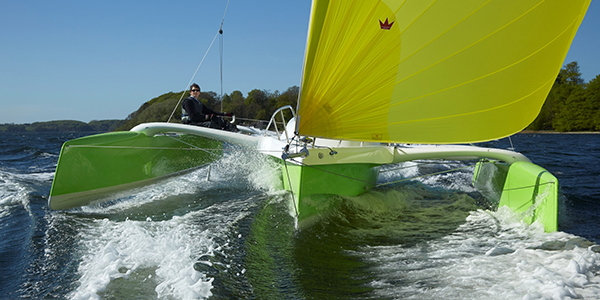
The Dragonfly 25 is a easily trailerable trimaran for sailors looking for both performance and comfort.
Dragonfly 25.
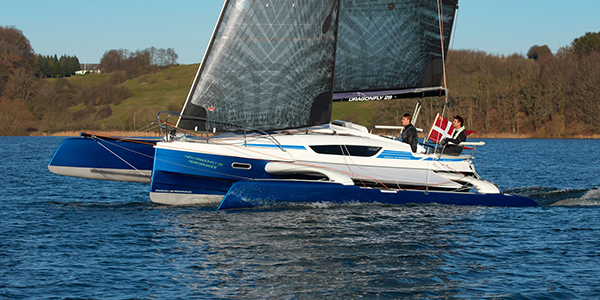
The Dragonfly 28 is an excellent trailerable trimaran built for performance and cruising comfort.
Dragonfly 28.
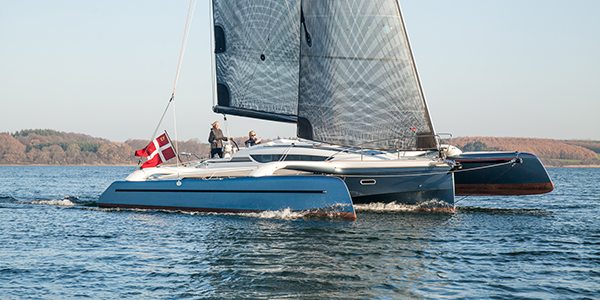
The Dragonfly 32 is the perfect combination between family cruising, racing, and offshore adventures.
Dragonfly 32.
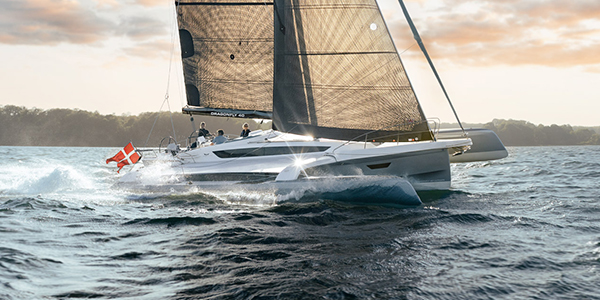
The all-new Dragonfly 40 Performance Cruiser is a cutting edge design with a spacious cockpit and stylish interior.
Dragonfly 40, dragonfly trimarans for sale in the us.
Dragonfly Trimarans are built in Denmark to extremely high standards by Quorning Boats. The current Dragonfly range extends from the trailerable 25 and 28 footers, up to the larger 32 and 40 foot models. All Dragonfly Trimarans employ their hallmark “swing wing” system for retracting the floats for docking or in the case of the 25 and 28 for easy trailering. One feature of this system is that the floats remain in the vertical orientation, which is an advantage when keeping the boat in a slip because it eliminates the issue of fouling of the outside surfaces of the floats. Another hallmark of Dragonfly trimarans is their attention to detail in the interior design and finish, creating a beautiful comfortable place to spend time inside the boat. If you are looking for a Dragonfly Trimaran for sale, Windcraft Multihulls is a US dealer located in the Southeastern United States. Contact us for more information.
Click here to read more about why you should buy a Dragonfly Trimaran.
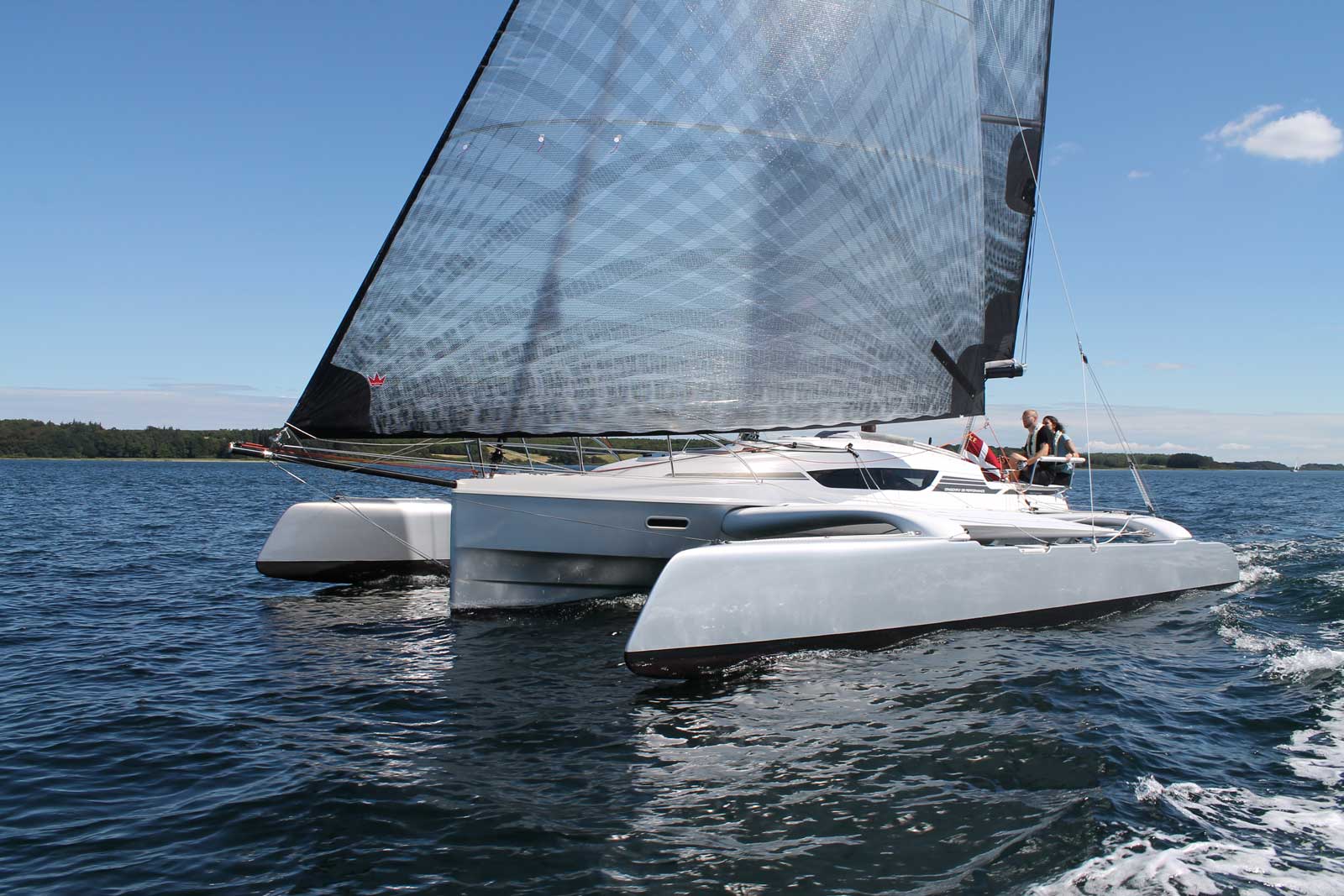
Dragonfly Demo Sails
We have several locations around the country where you can try out a Dragonfly trimaran. Please call or email us [...]
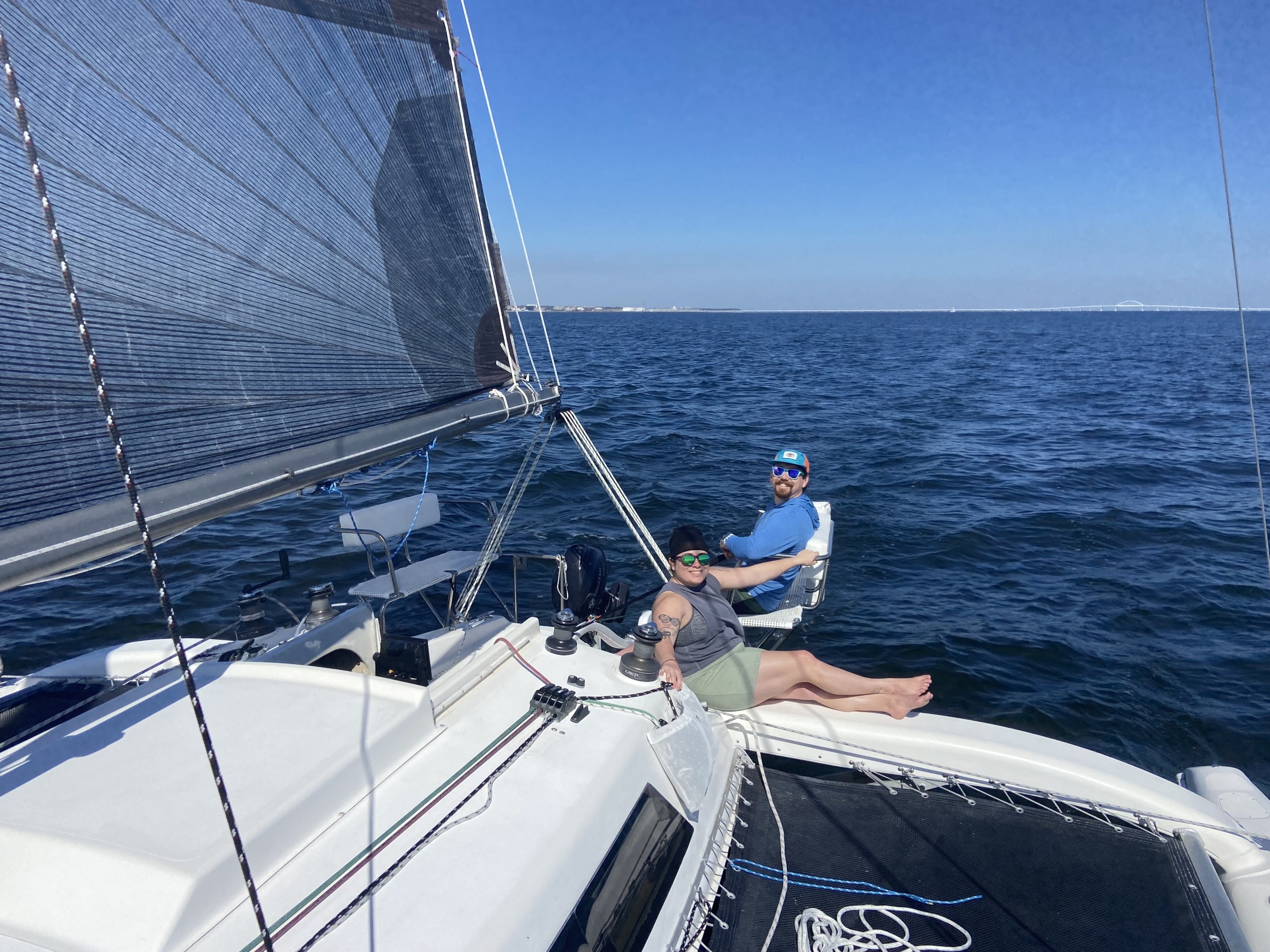
Corsair Demo Sails
Windcraft is pleased to be able to offer demo sails with our partner Tommy Clark on [...]
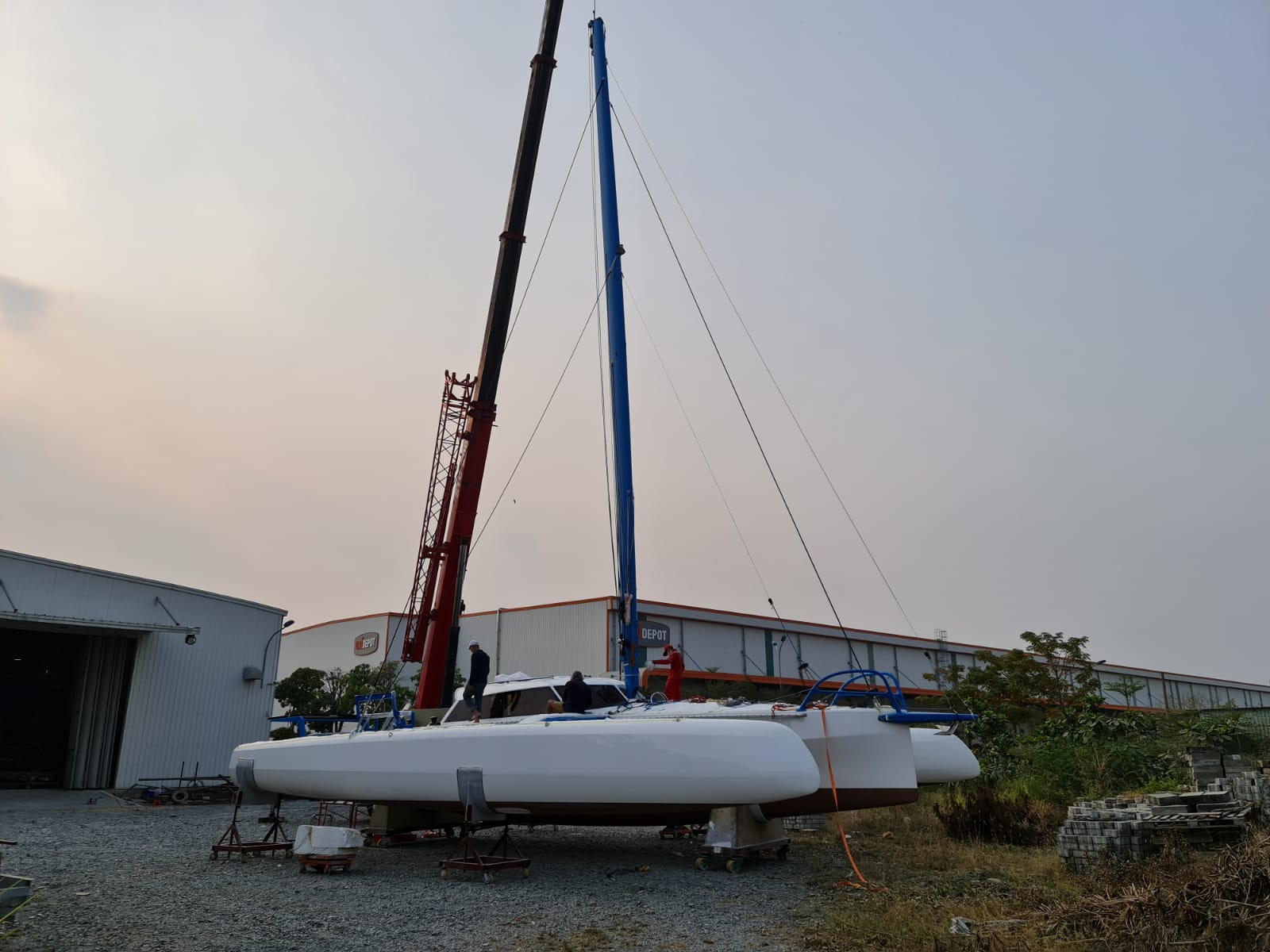
Rapido Trimaran update
Rapido Trimarans offers four ultra modern, high performance cruising trimarans, the Rapido 40 and Rapido 50,Rapido 53 XS, and [...]

Corsair 37 video
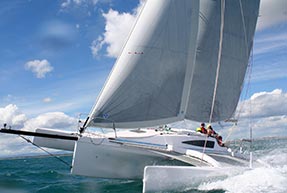
Cruze 970 video
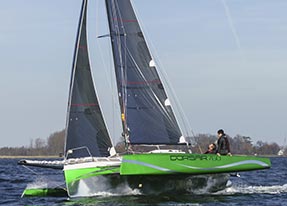
Corsair 760 video
Corsair 760 video

IMAGES
VIDEO
COMMENTS
Posts: 21. Corsair vs Dragonfly. How would those with direct experience with both rate the designs and build quality of Corsair and Dragonfly tris. I'm mostly interested in the Corsair 31UC and the Dragonfly 28 or the new 32 as a first boat. Also some have said that since Corsair has moved production to Vietnam the quality has gone down.
The Neel 47. Rapido 60. Dragonfly 28. The Pulse 600. Corsair 37. These tris are built with your safety in mind while also packing powerful speed and a wide array of comfort features to optimize your sailing experience, some are even foldable making them possible to load on a trailer and transport to the sailing destination of your choosing.
Boat: Sunmaid 20, John Welsford Navigator. Posts: 9,549. Re: Help deciding on a Tri besides Dragonfly & Corsair. "Tramp" is correct, at least in Australia, designed by Ian farrier, built by John Haines. In America they were also known as "Eagle' i think and also Ostar Tramp/Eagle was a later model. Great little sailing boat with a huge cockpit ...
However, in an F-boat, it is easier to get the winward ama out of the water in light air, and the boat will feel more agile. F31's are always faster than my 920. Sailing on DF920 (and up) will be dramatically dryer than on F24. Also, F24 are often sailed as sport boats - hiking out on windward ama, spray, excitement.
The Dragonfly is more like a BMW: Heavier, but still fast, manoeuvrable, roomy with creature comforts. In camper terms: The Farrier is like a Coleman, minimalist with carpet on the bulkheads and overheads. The DF is like an Airstream, solid, with teak, sometimes leather and accommodations.
Corsair/Farrier vs Dragonfly I've sailed and toured multiple Corsair/Farriers and own a Dragonfly 1000. The following is opinion, not intended to offend advocates of either. ... Obviously, the trimaran has more exterior room. A buddy has a Bavaria 38 and everyone is always crowded into the cockpit. His family came aboard my boat and immediately ...
Fans of folding trimarans know how much the Corsair 31 left its mark on people's minds. With more than 300 examples built, it is one of the yard's best-sellers. ... The first-generation Dragonfly 32 marked the history of Quorning Boats with more than 50 examples built. The Evolution replaced the Supreme version in 2019, with 20% larger ...
Trimaran Corsair vs Dragonfly
Hello, The DF-35 does have a full double aft bunk, and it is definitely a faster boat than the DF-1200. The 1200 might have a higher top speed, but the 35 will be faster in light air and get into "the teens" much sooner than the 1200. In moderate 10-20 knot winds a 35 will run away from a 1200. What you lose in speed you more than make up in ...
The Dragonfly 32 Evolution is a high-performance trimaran designed and built by the Danish company Quorning Boats. It is an updated version of the popular Dr...
Trimarans tend to be more performance oriented than catamarans. In part, this is because it's easier to design a folding trimaran, and as a result Farrier, Corsair, and Dragonfly trimarans had a disproportionate share of the market. In spite of this and in spite of the fact that many are raced aggressively in windy conditions, capsizes are ...
180 Marine is an authorized dealer for Corsair and Dragonfly trimarans. We are the fastest-growing Corsair trimaran dealer in the United States. Most of our Corsair trimarans are received and commissioned in Long Beach, California, and then professionally transported or picked up by each customer for the final sailing destination. 180 Marine is ...
3 Small, Sporty Trimarans. The experience provided by three hulls will be uniquely different aboard this trio of thoroughly modern trimarans, the Telstar 28, the Dragonfly 35, and the Corsair 31. A boat review from our November 2008 issue. When it comes to cruising multihulls, the trimaran often plays second fiddle.
The Dragonfly is decked out with wood inside while the corsair is just a basic fiber shell. Lightship (even if maker is off) is no where near 3900 kg States 2490kg Corsair Marine Trailerable Trimaran - Yacht Models Dragonfly 3900kg Dragonfly Trimarans by Quorning Boats of Denmark | DRAGONFLY 35 Specifications Also comparing a Dragonfly 35' vs a ...
Dragonfly 28. The Dragonfly 28 offers a unique design that comes with not only one but two great new trimarans: the 28 Touring version and the Dragonfly 28 Performance Trimaran. The Performance Dragonfly 28, on the other hand, also comes in two versions, the Inshore and Offshore racer, perfect for people who love sports and adventure.
However, it recently occurred to me there is an exception to this rule, and that is aboard a performance trimaran like the Corsair 880. - Adam Cort from SAIL Magazine. Despite the boat's go-fast looks, complete with a drop-dead gorgeous tumblehome bow (flared to help keep the spray down underway), there's standing headroom in the narrow ...
More Corsair owners have chosen 180 Marine than any other source. The new Corsair 880 Sport arrives in Austin Texas, August 2020. This is the first one (hull #3) to be sailed in the US. Contact Richard Allen, the Corsair trimaran expert from 180 Marine for more info. [email protected].
Folding Corsair Trimarans: Legendary Ability, Unbeatable Reliability; 5 Reasons Why The Corsair 760 Trimaran Won Multihull Of The Year; Pages. Corsair Range Brochure; Corsair Community; Find A Dealer; CONTACT US. Tel +84 28 3873 3630. Sales Enquiry: [email protected]. Customer Service Enquiry:
Perhaps the greatest obstacle for many boat buyers will be the high entry price of the F-31—$97,500 base. That's before sails, trailer and motor. The construction of a fold-up trimaran is extremely labor intensive, which drives up the cost. And, of course, there are many moldings that make up the akas and amas.
Hi! I would like to know of Trimaran builders besides Corsair and Dragonfly (I know about them). Any country is fine. I want to know of the smaller shops and good custom builds. I am aware of Farrier ... Corsair vs Dragonfly: modifier: Multihull Sailboats: 25: 25-02-2012 14:29: Advertise Here. Recent Discussions: Is anybody else finding dealing...
Dragonfly Trimarans are built in Denmark to extremely high standards by Quorning Boats. The current Dragonfly range extends from the trailerable 25 and 28 footers, up to the larger 32 and 40 foot models. All Dragonfly Trimarans employ their hallmark "swing wing" system for retracting the floats for docking or in the case of the 25 and 28 ...
If you are planning on keeping the boat in a slip that requires you to fold the amas, the Dragonfly 35's amas fold back, making the boat longer, but painting it with antifouling paint is no problem. The Corsair 37's amas fold down, which would mean you would have to paint almost the entire ama with antifouling paint. The Corsair is a faster, lighter boat, but by the time it would get loaded it ...
Some 24's have heads, mine does not. The flip side is weight, you will need a more capable vehicle to tow a 27/28. Newer versions will have performance improvements such as a rotating mast. The oldest 24's (Mk1) have a centerboard rather than daggerboard, and while a little slower, are better suited to cruising.